Ingalls Peak
Ingalls Peak is a 7,662-foot (2,335-metre) triple-summit mountain located in the Alpine Lakes Wilderness, along the common border of Kittitas County and Chelan County, in Washington state.[4] Ingalls Peak is the highest point in the Teanaway area of the Wenatchee Mountains.[1] It is situated 2 mi (3.2 km) west of Mount Stuart, and immediately west of Lake Ingalls, on land managed by Wenatchee National Forest. Its subpeaks are the South Peak (7,640-ft, 2,329-m) and the East Peak (7,480-ft, 2,280-m).[1] Precipitation runoff from the peak drains north into Jack Creek, a tributary of Icicle Creek; west into Fortune Creek; or east into Ingalls Creek, a tributary of the Wenatchee River. This peak, the lake, creek, and pass are named for Captain Benjamin Ingalls of the United States Cavalry who led an 1855 survey of this area and is credited with discovering gold in the region.[5]
| Ingalls Peak | |
|---|---|
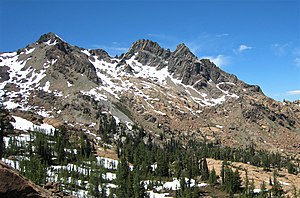 Ingalls Peak, east aspect | |
| Highest point | |
| Elevation | 7,662 ft (2,335 m) [1] |
| Prominence | 1,222 ft (372 m) [1] |
| Parent peak | Mount Stuart (9,415 ft)[2] |
| Isolation | 2.07 mi (3.33 km) [2] |
| Coordinates | 47°28′21″N 120°56′47″W [1] |
| Geography | |
 Ingalls Peak Location of Ingalls Peak in Washington  Ingalls Peak Ingalls Peak (the United States) | |
| Location | Chelan County/Kittitas County Washington, U.S. |
| Parent range | Wenatchee Mountains Cascade Range |
| Topo map | USGS Mount Stuart |
| Geology | |
| Type of rock | Peridotite[3] |
| Climbing | |
| First ascent | 1925 |
| Easiest route | class 4 scrambling[2] |
Climbing
Ingalls Peak is a popular climbing destination because of its generally sound peridotite rock and relatively easy access.[3] The North Peak is the highest, and its easiest climbing route is rated class 4 by either the Southwest Face or East Ridge. The first ascent was made in 1925 by a party of The Mountaineers. The South Ridge is a popular route, class 5.4 rating. This route was first climbed by Keith Lankin and Ken Solberg on May 30, 1941. The Southeast Face was first climbed in June 1956 by Lex Maxwell and Bob McCall.
The South Peak is the easiest ascent, involving only class 3 scrambling.
The East Peak is a classic horn shape, and the most difficult to reach the top, minimum class 5 climbing. This summit was first climbed by Gene Prater, Bill Prater, and Stan Butcharc in November 1952. There are established routes on the South Face, Southwest Face, and Dike Chimney - East Ridge.
Climate
Lying east of the Cascade crest, the area around Ingalls Peak is a bit drier than areas to the west. Summers can bring warm temperatures and occasional thunderstorms. Most weather fronts originate in the Pacific Ocean, and travel east toward the Cascade Mountains. As fronts approach, they are forced upward by the peaks of the Cascade Range, causing them to drop their moisture in the form of rain or snowfall onto the Cascades (Orographic lift). As a result, the western slopes of the Cascades experience high precipitation, especially during the winter months in the form of snowfall. During winter months, weather is usually cloudy, but, due to high pressure systems over the Pacific Ocean that intensify during summer months, there is often little or no cloud cover during the summer.[3]
Geology
The Alpine Lakes Wilderness features some of the most rugged topography in the Cascade Range with craggy peaks and ridges, deep glacial valleys, and granite walls spotted with over 700 mountain lakes.[6] Geological events occurring many years ago created the diverse topography and drastic elevation changes over the Cascade Range leading to the various climate differences.
The history of the formation of the Cascade Mountains dates back millions of years ago to the late Eocene Epoch.[7] With the North American Plate overriding the Pacific Plate, episodes of volcanic igneous activity persisted.[7] In addition, small fragments of the oceanic and continental lithosphere called terranes created the North Cascades about 50 million years ago.[7]
During the Pleistocene period dating back over two million years ago, glaciation advancing and retreating repeatedly scoured the landscape leaving deposits of rock debris.[7] The last glacial retreat in the Alpine Lakes area began about 14,000 years ago and was north of the Canada–US border by 10,000 years ago.[7] The “U”-shaped cross section of the river valleys are a result of that recent glaciation. Uplift and faulting in combination with glaciation have been the dominant processes which have created the tall peaks and deep valleys of the Alpine Lakes Wilderness area.
Gallery
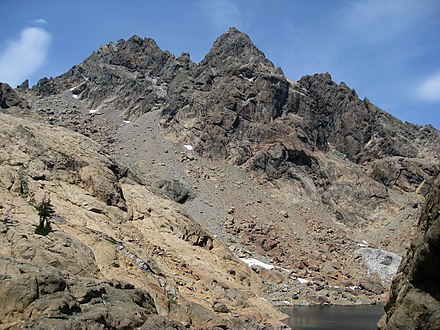 East Peak centered (North Peak left)
East Peak centered (North Peak left)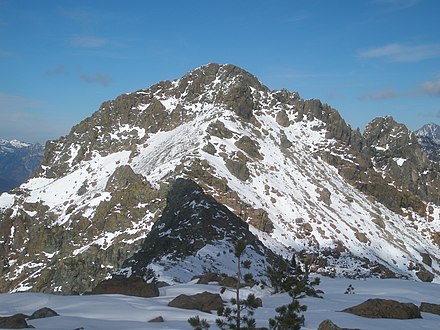 South Peak from SSW on Fortune Peak
South Peak from SSW on Fortune Peak- From the southeast
.jpg) Ingalls Peak and Lake Ingalls
Ingalls Peak and Lake Ingalls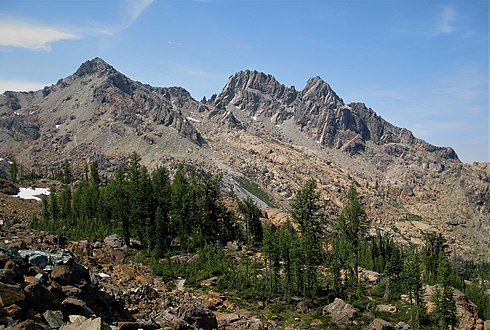 Ingalls Peak
Ingalls Peak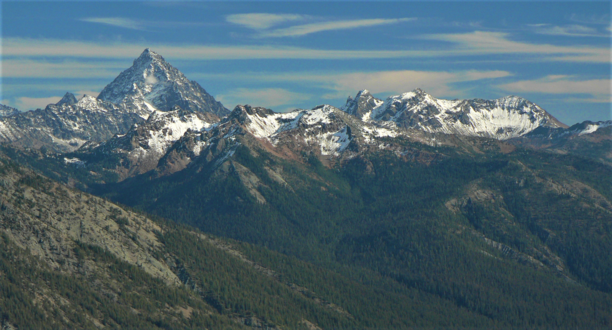 Mt. Stuart, Scatter Peak, Ingalls Peak (right of center) from northwest
Mt. Stuart, Scatter Peak, Ingalls Peak (right of center) from northwest
References
- "Ingalls Peak, Washington". Peakbagger.com.
- "Ingalls Peak - 7,662' WA". listsofjohn.com. Retrieved 2020-06-18.
- Beckey, Fred W. Cascade Alpine Guide, Climbing and High Routes. Seattle, WA: Mountaineers Books, 2008.
- "Ingalls Peak". Geographic Names Information System. United States Geological Survey. Retrieved 2020-06-18.
- Barnes, Nathan and Jeremy, Alpine Lakes Wilderness: The Complete Hiking Guide, Mountaineers Books. 2019.
- Smoot, Jeff (2004). Backpacking Washington's Alpine Lakes Wilderness. Helena, Montana: The Globe Pequot Press.
- Kruckeberg, Arthur (1991). The Natural History of Puget Sound Country. University of Washington Press.
External links
- Ingalls Peak weather: Mountain Forecast
- Climbing the South Ridge: YouTube